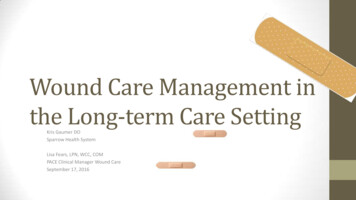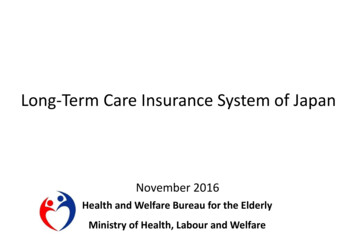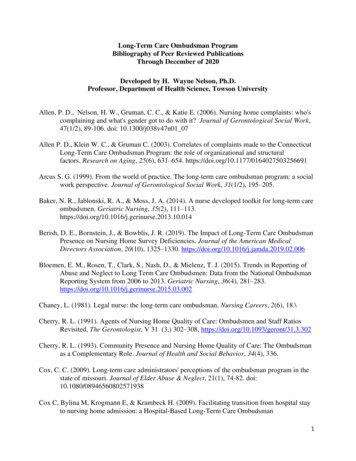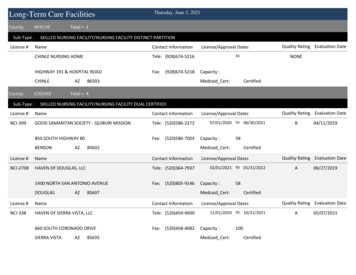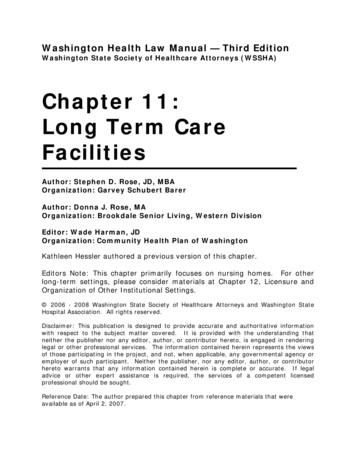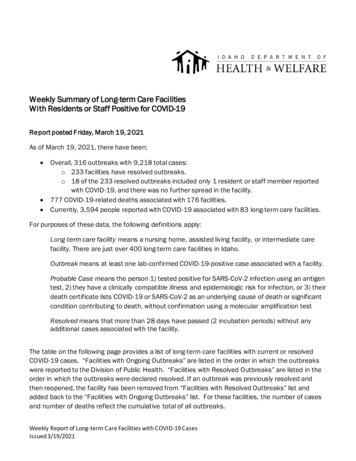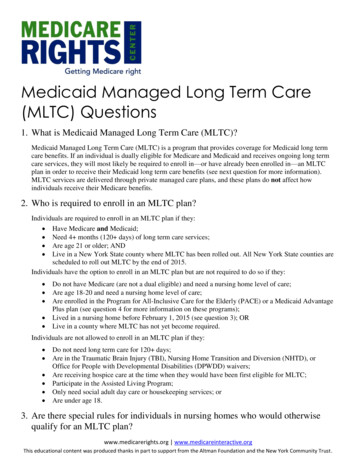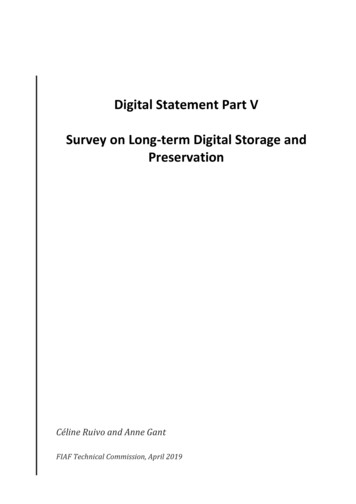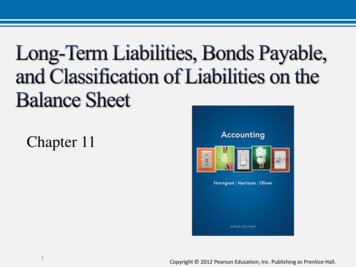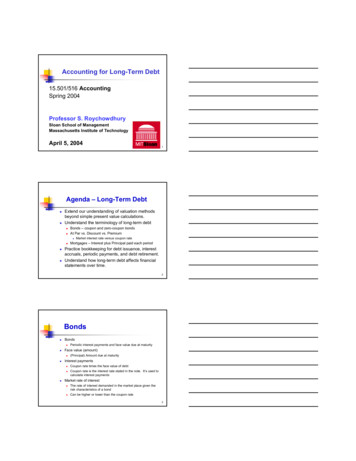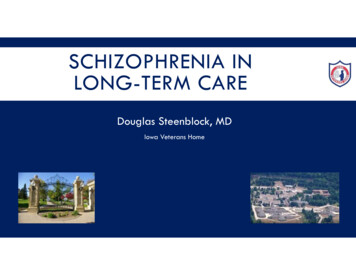
Transcription
SCHIZOPHRENIA INLONG-TERM CAREDouglas Steenblock, MDIowa Veterans Home
DISCLOSURES NONE2
OBJECTIVES Discuss the psychopharmacologic management ofschizophrenic patients in long-term care settings. Identify the unique clinical aspects of schizophrenia inlate life.3
SCHIZOPHRENIA “Dementia Praecox” Lifetime prevalence of 1% (male female) 0.1-0.5% of elderly Peak age of onset: 10-25 (men) 25-35 (women) Ventricular enlargement, cortical atrophy and soft neurological signs. Prodrome often occurs prior to onset.4
AGE OF ONSET Early onset: Up to age 40 (45) 75-80% of cases Late onset: 40-60 Often female Better prognosis Very late onset: 60 Rare More medical co-morbidities5
SCHIZOPHRENIA Cause unknown. Risk factors: Genetics. 50% concordance monozygotic twins. Winter/spring birth. Influenza during pregnancy. Dopamine Hypothesis: Increased limbic, decreased frontal. Other neurotransmitters also implicated6
SCHIZOPHRENIA:DIAGNOSTIC CRITERIA 2 or more of following actively occurring over 1 monthperiod: Delusions* Hallucinations* Disorganized speech* Grossly disorganized or catatonic behavior Negative symptoms Total duration of illness 6 months or more7
SCHIZOPHRENIA SYMPTOMS Positive Symptoms: Delusions Hallucinations Disorganized speech Disorganized behavior Negative Symptoms: Affect flat Alogia (mute) Avolition Autistic Apathy Ambivalence Anhedonia Etc.8
PSYCHOTIC SYMPTOMSSchizophrenia:Dementia-related psychosis: Bizarre or complex delusions Misidentification Auditory hallucinations Well-formed visual hallucinations Long-term Usually remits9
COGNITIVE IMPAIRMENT More than 70% of schizophrenics affected. May be less impactful for late-onset cases. May be worse in institutionalized vs. community. May affect executive function, memory, IQ, visuospatial function,processing speed, attention, arithmetic and verbal fluency. Cognitive abilities may remain stable over the course of the illness inmany patients. Those in nursing homes more likely to decline. Schizophrenics overall have higher risk of dementia.10
SCHIZOPHRENIA TREATMENT Antipsychotic medication: Conventional/Typical (1st Gen) Dopamine (D2) antagonist Novel/Atypical (2nd Gen) Dopamine & serotonin antagonist ECT Safe and effective option for older schizophrenics. Psychosocial: Social skills training, supported employment, cognitive remediation, psychotherapy,groups. Family support and case management.11
ANTIPSYCHOTICSFirst Gen (Typical)Second Gen (Atypical) Haloperidol (Haldol) Fluphenazine (Prolixin) Thiothixine (Navane) Perphenazine (Trilafon) Trifluperzaine (Stelazine) Thioridazine (Mellaril) Chlorpromazine (Thorazine) Loxapine (Loxitane) Others Risperidone (Risperdal)* Olanzapine (Zyprexa)* (Trade names in parentheses) Clozapine (Clozaril) Quetiapine(Seroquel) Ziprasidone (Geodon) Apiprazole (Abilify) Paliperidone (Invega) Lurasidone (Latuda) Asenapine (Saphris) Iloperidone (Fanapt) Others12
EXTRAPYRAMIDAL SIDE EFFECTS (EPS)Other:Parkinsonism: 20-35% overall prevalence Higher for elderly Resting tremorRigidityBradykinesiaShuffling gait Dystonia (torticollis, oculogyric)DroolingAkathisia (restlessness)Tardive dyskinesia Treat with anticholinergic oramantadine.13
TARDIVE DYKINESIA Abnormal movements of face/mouth such as lip smacking, clenching,chewing, puckering, and tongue thrusting. May also see choreiformmovements in limbs. Prevalence 20-30% overall (50-60% for elderly). Usually develops over months or years, but sometimes sooner. Most cases are irreversible (dopamine receptor sensitivity altered). Risk factors: Female, higher negative/positive symptoms, greatercognitive impairment, other drug-induced movements, substance use,diabetes.14
TARDIVE DYSKINESIA: MANAGEMENT Prevention: Screening is crucial. Choose antipsychotics with less risk. Once TD starts, switching maybe ineffective. Anticholinergics may worsen; try to eliminate. Reduction in dose may worsen. Consider severity and impact on patient. VAMT2 inhibitors: Valbenazine Deutetrabenazine15
RELATIVE RISK OF EPS FORATYPICAL iprazole16
NEUROLEPTIC MALIGNANT SYNDROME (NMS) Associated with initiation of or increase in antipsychotic. High doses or multiple antipsychotics have higher risk. Features: Confusion, delirium, tremor, stiffness, autonomic instability, fever,death. Creatinine Kinase markedly elevated; WBC and LFTs may be elevated aswell. Tx: Stop antipsychotic, admit to medical, supportive measures, may needbromocriptine , dantrolene or amantadine.17
ANTICHOLINERGIC SIDE EFFECTS Increased confusion Dry mouth Blurred vision Constipation Urine retention18
METABOLIC SYNDROME Mainly associated with second generation (atypical) agents. Weight gain, hyperlipidemia, hyperglycemia, higher risk ofdiabetes. 32.5% of schizophrenics. Metformin may be beneficial. Risk for weight gain: Higher Risk: Olanzapine, clozapine Medium Risk: Risperidone, quetiapine, paliperidone Lower Risk: Aripiprazole, ziprasidone, lurasidone, asenapine, haloperidol19
OTHER COMPLICATIONS Orthostatic hypotension (falls) Hyperprolactinemia Cardiac conduction (QT prolongation) Seizures Antihistaminic: Sedation Weight gain20
CLOZAPINE May be used in cases of EPS sensitivity or non-response totreatment. Requires monitoring of WBC/ANC due to risk ofagranulocytosis (q 1-4 weeks). Other possible liabilities: Seizure riskMetabolicCardiomyopathyAnticholinergic21
LONG-TERM INJECTABLE ANTIPSYCHOTICS Haloperidol, risperidone, paliperidone, aripiprazole and others. Intervals vary from 2 weeks to 3 months. Outcomes in controlled settings may not be superior to oral.22
DEPRESSION May be difficult to differentiate from negative symptoms. Rule out medical conditions that may mimic depression. Not particular agent favored. Use atypical antipsychotics. Consider psychotherapy. Important to treat: Cognition Suicide risk23
SUICIDE RISK Suicidal ideation prevalence: 10% current, 56% lifetime. Risk factors: Multiple hospitalizations, previous attempts, comorbid mood and personality disorders, substance abuse. Major depression schizophrenia greatly increased risk24
SCHIZOPHRENIA: PROGNOSIS About 60% of patients have substantial improvement orfull remission of positive symptoms on antipsychoticmedication. Many experience slow functional deterioration overlifetime. Most will not be able to work (unless supported). Less likely to drive, marry, or live independently than bipolarcohorts. Lower socioeconomic status: “Downward Drift”25
SCHIZOPHRENIA-SPECTRUMDISORDERS26
SCHIZOPHRENIFORM DISORDER Same criteria for Schizophrenia, but total duration isless than 6 months. Often rapid onset. Prognosis is better. Treated with antipsychotics, but may not need longterm.27
SCHIZOAFFECTIVE DISORDER Elements of schizophrenia combined with elements of eitherbipolar disorder or major depression. The mood Sx (mania and/or depression) must account for asubstantial portion of the total duration of the illness. Patient has periods (2 weeks or more) of psychosis occurringduring times when they are not manic or depressed. Bipolar/Depressive Types. With catatonia28
SCHIZOAFFECTIVE DISORDER:TREATMENT Similar to schizophrenia, but also mood stabilizers andantidepressants. Prognosis similar to schizophrenia29
SCHIZOTYPAL PERSONALITY DISORDER A pervasive pattern of social and interpersonal deficits marked by acute discomfortwith, and reduced capacity for, close relationships as well as by cognitive orperceptual distortions and eccentricities of behavior, beginning by early adulthoodand present in a variety of contexts, as indicated by five (or more) of the following: Ideas of reference (excluding delusions).Odd beliefs or magical thinking that influences behavior and is inconsistent with subcultural norms.Unusual perceptual experiences, including bodily illusions.Odd thinking and speech.Suspiciousness or paranoid ideation.Inappropriate or constricted affect.Behavior or appearance that is odd, eccentric, or peculiar.Lack of close friends or confidants other than first-degree relatives.Excessive social anxiety that does not diminish with familiarity and tends to be associated with paranoidfears rather than negative judgments about self. Late-onset schizophrenics are often diagnosed with cluster A personality disordersprior to the onset of schizophrenia.30
ISSUES IN LONG-TERM CARE31
NURSING HOMES Have become defacto institutions for those with serious mentalillness (SMI), following deinstitutionalization and closing of statehospitals. In VA system, as inpatient beds and stays decreased, prevalenceof SMI in nursing homes increased. 2.7-7.1% of nursing home residents have SMI. 80% of schizophrenics live in the community.32
NURSING HOMES Residents with SMI more likely to stay long term. Residents with SMI are younger: Average age at time of entry is 65 for SMI, and 80 for those who are not SMI. Middle aged patients with schizophrenia are 4 times more likely to need nursinghome placement than same-age peers without SMI. Nursing homes with larger percentage of SMI residents tend to belower in quality: Staffed at lower levels, higer Medicaid, use restraints more, more ulcers, morefeeding tubes, more catheters, more hospitalizations, more deficiency citations.33
NURSING HOMES Compared with community cohorts, patients with SMI in nursinghomes are more likely to have severe psychiatric symptoms,greater cognitive deficits, more functional and physicalimpairment, more aggressive behavior, and less social support. In nursing homes, those with dementia alone had more aggressivebehavior than those who had SMI alone. But those who haddementia AND SMI had the highest rates of all. Challenges: Training for staff, finding psychiatric providers,developing appropriate activities for younger residents.34
CO-MORBID MEDICAL CONDITIONS Tend to be exacerbated by schizophrenia. Schizophrenics often receive inadequate healthcare. Medications may have long-term effects. Substance use (including tobacco) may contribute.35
END-OF-LIFE CARE FOR SCHIZOPHRENICS More likely than cohorts to die in nursing homes. Less likely to see (non-psychiatric) specialists. Less likely to be prescribed analgesics. Less likely to receive palliative care. Psychiatric medications should be continued as comfort care.36
ANTIPSYCHOTIC REDUCTION Length of treatment guidelines vary for all age groups. Very little research on reductions for older schizophrenics. Risk/benefit analysis is needed (including patient preference). Patients on the ends of the severity spectrum may be bestcandidates.37
ANTIPSYCHOTIC REDUCTION For all age groups, following factors are associated with lowerrate of relapse after discontinuation: Low dose prior to discontinuation. Older age. Shorter duration of untreated psychosis. Lower severity of positive symptoms. Better social functioning. Lower number of previous relapses. Later onset.38
QUESTIONS?39
References:1. Amad A, Geoffroy PA, Vaiva G, Thomas P. [Personality and personality disorders in the elderly: diagnostic, course and management]. Encephale. 2013 Oct;39(5):374‐82. doi: 10.1016/j.encep.2012.08.006. Epub 2012 Oct 24. Review.2. Andrews AO, Bartels SJ, Xie H, Peacock WJ. Increased risk of nursing home admission among middle aged and older adults with schizophrenia. Am J Geriatr Psychiatry. 2009 Aug;17(8):697‐705.3. Aschbrenner K, Grabowski DC, Cai S, Bartels SJ, Mor V. Nursing home admissions and long‐stay conversions among persons with and without serious mental illness. J Aging Soc Policy. 2011 Jul‐Sep;23(3):286‐304.4. Bartels SJ, Pratt SI. Psychosocial rehabilitation and quality of life for older adults with serious mental illness: recent findings and future research directions. Curr Opin Psychiatry. 2009 Jul;22(4):381‐5.5. Becker M, Andel R, Boaz T, Howell T. The association of individual and facility characteristics with psychiatric hospitalization among nursing home residents. Int J Geriatr Psychiatry. 2009 Mar;24(3):261‐8.6. Bowersox NW, Szymanski BJ, McCarthy JF. Associations between psychiatricinpatient bed supply and the prevalence of serious mental illness in Veterans Affairs nursing homes. Am J Public Health. 2013 Jul;103(7):1325‐31.7. Caroff SN. Overcoming barriers to effective management of tardive dyskinesia. Neuropsychiatr Dis Treat. 2019 Apr 4;15:785‐794. doi: 10.2147/NDT.S196541. eCollection 2019. Review.8. Cen X, Li Y, Hasselberg M, Caprio T, Conwell Y, Temkin‐Greener H. Aggressive Behaviors Among Nursing Home Residents: Association With Dementia and Behavioral Health Disorders. J Am Med Dir Assoc. 2018 Dec;19(12):1104‐1109.e4.9. Chochinov HM, Martens PJ, Prior HJ, Kredentser MS. Comparative health care use patterns of people with schizophrenia near the end of life: a population‐based study in Manitoba, Canada. Schizophr Res. 2012 Nov;141(2‐3):241‐6.10. Citrome L. Clinical management of tardive dyskinesia: Five steps to success. J Neurol Sci. 2017 Dec 15;383:199‐204. Nov 16. Review.11. Dickerson FB. Women, aging, and schizophrenia. J Women Aging. 2007;19(1‐2):49‐61.12. Essali A, Ali G. Antipsychotic drug treatment for elderly people with late‐onset schizophrenia. Cochrane Database Syst Rev. 2012 Feb 15;(2):CD004162.13. Felmet K, Zisook S, Kasckow JW. Elderly patients with schizophrenia and depression: diagnosis and treatment. Clin Schizophr Relat Psychoses. 2011 Jan;4(4):239‐50.14. Folsom DP, Lebowitz BD, Lindamer LA, Palmer BW, Patterson TL, Jeste DV. Schizophrenia in late life: emerging issues. Dialogues Clin Neurosci. 2006;8(1):45‐52.15. Mental Illness In Nursing Homes: Variations Across States. Grabowski DC, Aschbrenner KA, Feng Z, Mor V. Health affairs (Project Hope). 2009 May–Jun; 28(3): 689‐700.16. Guo JY, Ragland JD, Carter CS. Memo
schizophrenic patients in long-term care settings. Identify the unique clinical aspects of schizophrenia in late life. 3. SCHIZOPHRENIA “Dementia Praecox” Lifetime prevalence of 1% (male female) 0.1-0.5% of elderly Peak age of onset: 10-25 (men) 25-35 (women) Ventricular enlargement, cortical atrophy and soft neurological signs. Prodrome often occurs prior to onset. 4. AGE OF ONSET Early .
